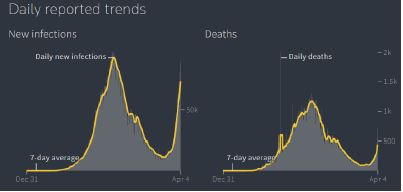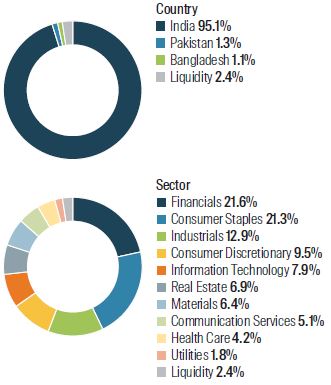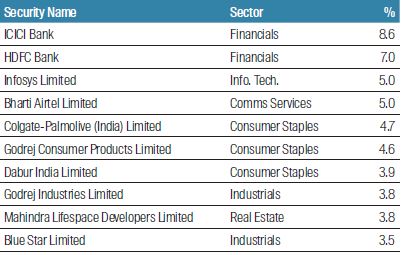Please read the following important information for FSSA Indian Subcontinent Fund
• The Fund invests primarily in equity securities and equity related securities in Indian subcontinent which may expose to potential changes in tax, political, social and economic environment.
• The Fund invests in emerging markets which may have increased risks than developed markets including liquidity risk, currency risk/control, political and economic uncertainties, high degree of volatility, settlement risk and custody risk.
• Investing in small /mid-capitalisation securities may have lower liquidity and their prices are more volatile to adverse economic developments.
• The Fund’s investments may be concentrated in a single country/ sector, specific region or small numbers of countries/ companies which may have higher volatility or greater loss of capital than more diversified portfolios.
• The Fund may use FDIs for hedging and efficient portfolio management purposes, which may subject the Fund to additional liquidity, valuation, counterparty and over the counter transaction risks.
• It is possible that a part or entire value of your investment could be lost. You should not base your investment decision solely on this document. Please read the offering document including risk factors for details.

FSSA Indian Subcontinent Fund
Monthly Manager Views - March 2021
As bottom-up investors, the FSSA team carry out well over 1,500 meetings each year to assess company managements’ capabilities and the underlying strength of the franchises they run. These Monthly Manager Views are based on the team’s discussions with company management and the in-depth analysis that follows.
Pricing power
Every company we speak to these days tells us about the cost pressure that they are facing, emanating from rising global commodity prices. Domestic steel prices have risen by 35% year-over-year (YoY), copper by over 50% YoY and palm oil by over 60% YoY through February 2021. Indian corporates are being forced to reckon with sharp increases in input costs for the first time in almost a decade. We believe that pricing power is often the critical litmus test of a franchise’s quality.
Leading consumer staples businesses typically emerge stronger from such periods. Rising agricultural commodity prices drive rural incomes higher and strengthen consumer demand.
Category leaders gain market share from their unorganised sector competitors, who struggle to pass on higher costs to consumers. These leaders gain operating leverage as well – their revenue growth accelerates with higher selling prices, while they find ways to cut discretionary costs.
For example, operating profit growth of Hindustan Unilever, the largest fast-moving consumer goods (FMCG) company in India, accelerated during periods of input cost inflation such as FY08 to FY09 and FY11 to FY12. Its management is likely to use the current period of cost inflation to its advantage as well, as its competitive position across categories has strengthened further in recent years.
In contrast, the leader in India’s two-wheeler industry, Hero MotoCorp, has typically struggled during periods of high inflation. Consumers are highly price sensitive in the entry and executive segments in which it is dominant. Hero’s gross margins declined from 31% to 27% over FY06 to FY12 as it passed on only part of the increase in commodity prices during that period. It has raised prices significantly over the last two years after new safety and emission norms were mandated. Its management now faces the difficult choice between protecting its volumes or profitability. We own shares of Bajaj Auto in the portfolio, which will face a similar dilemma for its Indian two-wheeler business; however, over the years it has managed to diversify its business into multiple segments and geographies, and that helps Bajaj to defend its margins better than its competition.
Most of our portfolio companies have high gross margins, which means they have to make a smaller price hike to maintain their profitability compared to companies with lower gross margins. They have also displayed an ability to protect and even improve their profitability in inflationary environments over decades. What is more, these strong franchises come out with higher market shares through the inflationary periods. We are confident that they will achieve similar results in the current period as well.
Godrej Consumer Products
We have been shareholders of Godrej Consumer Products for many years. It has been one of the best consumer companies to own in India over the last two decades, generating an annualised return of 30% for its shareholders. However, the business has struggled in recent years due to a combination of weak consumer demand in each of its markets, as well as missteps by the company. It has appointed new leaders, whose actions suggest a new-found energy to step on the growth pedal and turn around what was not working. We recently spoke to the heads of Godrej Consumer Product’s businesses in each of its key markets – India, Indonesia and Africa.
India is the Group’s key market, contributing 70% of its operating profit. Consumer demand here has been hurt by repeated macroeconomic disruptions (demonetisation, Goods and Services Tax, the non-banking finance companies’ crisis and now Covid). Godrej’s pace of innovation had also slowed in recent years. This appears to be changing. The company has launched new products such as dishwashing liquids, toilet cleaners and floor cleaners, as consumer demand for these categories accelerates. It is also expanding distribution in rural areas and has created dedicated teams to focus on emerging channels like e-commerce. These initiatives indicate a renewed thirst for growth, which was absent in recent years.
Its international businesses have been built through mergers and acquisitions. In Indonesia, Godrej has grown its profits consistently by gaining share in a weak market environment. This steady growth should continue as it expands its footprint in the lucrative general trade channel and enters large new categories like hygiene products. Its foray into Africa, through several acquisitions made over a decade, has been a source of significant disappointment. However, there has been a key change here, as Dharnesh Gordhon, the ex-CEO of Nestle Nigeria, was appointed to lead Godrej’s African business last year. He is driving changes in each aspect of the business, from pricing to distribution, manufacturing and talent recruitment. Dharnesh had successfully led similar changes at Nestle. These initiatives have the potential to drive a multi-fold increase in Godrej Africa’s profits from a depressed base.
Temporary periods of difficulty in inherently strong businesses often provide the most attractive investment opportunities. Godrej operates in grossly underpenetrated and cash generative categories. The growth that has been missing in recent years is now likely to return. Following these engagements, our conviction in the investment case for our holdings has increased.
The second wave of Covid-19 in India
India entered 2021 amidst an environment of optimism. At the beginning of the year, we were hearing about the lives of our friends and family slowly returning to normal, with a steady decline in the active caseload of Covid-19 infections. Some commentators even suggested that India had achieved herd immunity, which now sounds laughable. Consumer demand was also strong across categories. But since mid-February, new Covid-19 cases have surged from approximately 10,000 daily to now more than 93,000 (as at April 4th), similar to its previous peak last September of 98,600 daily cases.

Source: Reuters, as at 4 April 2021: https://graphics.reuters.com/world-coronavirus-tracker-and-maps/countries-and-territories/india/
The speed of the current surge is worrying – the current increase in the daily caseload from 10,000 to 90,000 cases has taken only half the time it did last year. Fatality rates are likely to rise with a lag as well. However, there are two crucial differences between the two waves of the pandemic. The state of Maharashtra alone accounts for over half of new daily infections and the top five states account for 70%. Due to the high concentration of cases in a few cities and states, containment measures are localised. No large-scale regional or national lockdowns have been announced. The vaccination drive is also accelerating, after the government allowed private medical facilities to participate in the national vaccine program. Over 75 million vaccine doses have now been administered.
Our discussions with portfolio companies have made it clear that they are well-positioned to deal with the impact of the second wave of the virus on their businesses. They set up effective ways for their employees to work remotely and interact with their customers, suppliers and channel partners in the absence of in-person communication, and strengthened their balance sheets during the unprecedented lockdown last year. They emerged from the disruption with stronger market positions. We do not pay too much attention to quarterly results, but we noted that in the quarterly numbers reported through the peak uncertainty of last year our company holdings demonstrated an inherent management and franchise resilience, which has increased our conviction in their ability to deal successfully with the risks emerging from the surge in infections. We would view any decline in share prices arising from the second-wave of Covid-19 as an attractive opportunity to add to our holdings.

Source: First Sentier Investors as at 31 March 2021. The Fund is a sub fund of Ireland domiciled First Sentier Investors Global Umbrella Fund Plc.
Cumulative Performance in USD (%)

Calendar Year Performance in USD (%)

Asset allocation (%)†

Top 10 company holdings (%)

Source: Company data, FSSA Investment Managers, as of 4 April 2021
Important Information
The Fund is a sub fund of Ireland domiciled First Sentier Investors Global Umbrella Fund Plc. * Class I (USD-Acc) is the non-dividend distributing class of the fund. The performance quoted are based on USD total return (non-dividend distributing) of the respective class.
Δ MSCI India Net Index. Gross of tax benchmark performance is shown before 1 July 2016 and net of tax benchmark performance is shown after the aforementioned date. The Fund may hold multiple equity securities in the same company, which have been combined to provide the Fund’s total position in that company. Index weights, if any, typically include only the main domestic-listed security. The above Fund weightings may or may not include reference to multiple securities. On 22 September 2020, First State Indian Subcontinent Fund was rebranded as FSSA Indian Subcontinent Fund.
† Allocation percentage is rounded to the nearest one decimal place and the total allocation percentage may not add up to 100%.
Unless otherwise specified, all information contained in this document is as at 31 March 2021. Investment involves risks, past performance is not a guide to future performance. Refer to the offering documents of the respective funds for details, including risk factors. The information contained within this document has been obtained from sources that First Sentier Investors believe to be reliable and accurate at the time of issue but no representation or warranty, expressed or implied, is made as to the fairness, accuracy or completeness of the information. Neither First Sentier Investors, nor any of its associates, nor any director, officer or employee accepts any liability whatsoever for any loss arising directly or indirectly from any use of this. It does not constitute investment advice and should not be used as the basis of any investment decision, nor should it be treated as a recommendation for any investment. The information in this document may not be edited and/or reproduced in whole or in part without the prior consent of First Sentier Investors.
Reference to specific securities (if any) is included for the purpose of illustration only and should not be construed as a recommendation to buy or sell the same. All securities mentioned herein may or may not form part of the holdings of FSSA Investment Managers’ portfolios at a certain point in time, and the holdings may change over time.
This document is issued by First Sentier Investors (Hong Kong) Limited and has not been reviewed by the Securities and Futures Commission in Hong Kong. First Sentier Investors and FSSA Investment Managers are business names of First Sentier Investors (Hong Kong) Limited. The FSSA Investment Managers logo is a trademark of the MUFG or an affiliate thereof.
First Sentier Investors (Hong Kong) Limited is part of the investment management business of First Sentier Investors, which is ultimately owned by Mitsubishi UFJ Financial Group, Inc. (“MUFG”), a global financial group. First Sentier Investors includes a number of entities in different jurisdictions.
MUFG and its subsidiaries are not responsible for any statement or information contained in this document. Neither MUFG nor any of its subsidiaries guarantee the performance of any investment or entity referred to in this document or the repayment of capital. Any investments referred to are not deposits or other liabilities of MUFG or its subsidiaries, and are subject to investment risk, including loss of income and capital invested.